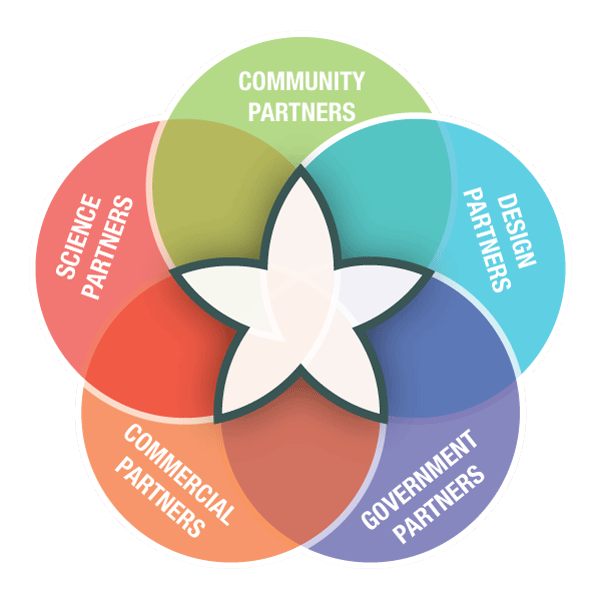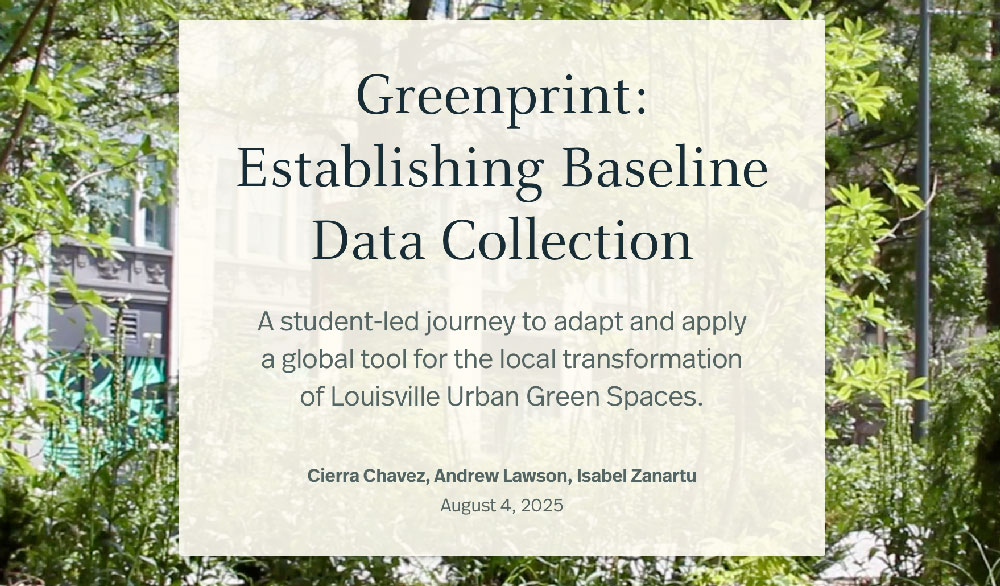
Greenprint is a 10-year, community-led initiative to transform downtown Louisville into a healthier, greener, and more resilient urban core. With an evidenced-based approach led by the University of Louisville’s Christina Lee Brown Envirome Institute and the Urban Design Studio, the project unites a diverse coalition of government agencies, nonprofits, community groups, developers, and design professionals around a shared commitment to improving human well-being through nature-based urban design.

By combining urban planning, ecology, and public health research, the Greenprint identifies where nature can have the greatest impact, aiming to determine the optimal dose of nature that can make a measurable difference in improving air quality, reducing heat, encouraging physical activity, and supporting community well-being. It's not just about planting trees; it’s about integrating the natural ecosystem into the heart of the city, maximizing its benefits for human and environmental health.
Rooted in scientific inquiry and civic collaboration, the Greenprint serves as both a local intervention and a scalable model for cities seeking to align environmental planning with public health outcomes, thereby shaping a new vision of urban life —one where nature and people thrive together.

The current Greenprint study area has a specific focus on downtown (yellow in the map above) as defined by the Ohio River to the north, York Street to the south, 9th Street to the west and Hancock Street to the east. The study boundary extends one-mile beyond downtown (light brown in the map above) to include potential connections to significant green spaces that could serve as ecological corridors into downtown.
We will begin by collecting essential baseline data to better understand current conditions in downtown Louisville. This includes measuring air pollution, urban heat, noise levels, and traffic patterns. We'll also assess how certain aspects of the built environment such as street layout, building density, and infrastructure contribute to stress or discomfort for people living and visiting the area.
In addition, we'll take a close look at the area's green spaces. We'll evaluate how many there are, what condition they are in, how accessible they are, and how well they connect to each other and the surrounding neighborhoods. This information will help guide thoughtful, targeted improvements moving forward.
As a foundational step in the Greenprint work, a cohort of summer interns will focus on assessing the current quality of urban green spaces within the Greenprint study area. The assessments will build on work completed by our partners at Parks Alliance of Louisville, not only looking at the qualities of urban design, but also biodiversity and other elements that create successful scopes that can improve environmental and human health. Establishing a strong baseline dataset is essential for tracking progress and guiding future greening initiatives.
Key objectives include:

Explore the summer student-led Urban Green Space Quality Assessment work in this StoryMap!
In order to grow our body of knowledge around evidence-based greening, it is essential to understand and learn from greening projects across the city, whether they fall within the Greenprint study area or beyond. Below you will find information we have gathered on greening efforts.

There are currently over 30 projects in Louisville that either focus on greening or have greening as a significant component.
The projects have been split into two categories on the map. Category 1 (green) projects have greening as a central focus. Category 2 (purple) have greening as a component of their projects.







Along with documenting the locations and plant lists of relevant projects, we are gathering data on the environmental impacts of greening efforts wherever possible to continually develop evidence-based planting methods. This includes metrics such as temperature, air pollution, and wildlife activity, as well as relevant scientific papers.
Data collection occurs either continuously (tracked consistently throughout the project) or as baseline measurements (captured for comparison before and after implementation). Links to the data and/or articles about the research will be shared when the data is publicly available.

Understanding the health impacts of urban greening is a critical focus of the Christina Lee Brown Envirome Institute at the University of Louisville. This data can include measures such as stress levels, heart rate, respiration, and other physiological indicators, alongside supporting scientific studies and survey findings.
Data collection methodologies encompass both continuous monitoring (capturing data consistently throughout a project) and baseline assessments (establishing pre- and post-intervention comparisons). Links to the data will be included when available.
If you are just looking for plant lists, this is the section for you. This section contains all the plant lists we have acquired from relevant projects and developments. These lists can also be found with their associated greening project cards in a section above. The collected plant lists are the most recent documents we have for each project, though they may not necessarily be the final plant list for projects currently underway.
• Trager MicroForest Project (Draft)
• Green Heart Louisville
• Alberta O Jones Park
• Speed Art Museum Green Space (Draft)
• East Market Streetscape Redesign
This section contains related research articles we think are of interest and that will help inform our greening projects.